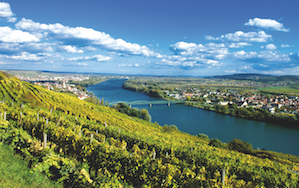“It is therefore vital in the current situation to finally harvest again an above average yield of at least 250m litres of wine,” says Klinger.
That is the only downside, bugbear of an otherwise positive 2014 for Austrian wine. After a difficult summer and autumn, the 2014 vintage came up short at just under 2m hl (the average is around 2.3m hl).
Onward and upward
Otherwise, it has been onward and upward for Austrian wine. Last June 24 was National Viticultural Day whereby the Austrian Winegrowers’ Association in cooperation with some scientific institutions has started the certification of wineries with sustainable working practices.
Association president Johannes Schmuckenschlager, says: “Sustainability should not be just a catchword but must be defined, verified and guaranteed.”
2014 will also go down as a milestone for Austrian sekt, or sparkling wine. The Austrian Sekt Committee has established October 22 as Austrian Sekt Day and has come up with a three-tier quality pyramid, which it claims is on a par with the highest standards of Champagne or Franciacorta – and in certain aspects, surpasses them.
Level one guarantees “mainly Austrian grapes” for the base wine and nine months on the lees. Level two must be bottle fermented and the grapes and base wine must come from a generic wine-growing region (federal state) and the maturation on the lees must be at least 18 months.
At the highest level, the grapes may be picked only from a single wine community, such as Poysdorf, Langenlois, Gols and Gamlitz, whereby vineyard designation is possible. After bottle fermentation, the sekt may be released at a minimum of three years following the harvest, including maturation on its lees for at least 30 months.
Sekt base wine makes up approximately 10% of domestic wine production.
Drinks International asked Klinger to put Austrian wine in context with the global wine market. He responds: “Austria produces less than 1% of the total international wine production, but with its small-scale, family-owned, high quality oriented wine production represents an increasingly visible role within the fine wine niche.
“Especially our signature grape, Grüner Veltliner, is getting more space in the on-trade distribution, because for innovative wine lists GV nowadays is a must.
“This is more the case also with specialised wine retail and upscale supermarkets. With the exception of Riesling, which is a different animal and has its place already, other Austrian wine categories in most non-German-speaking markets are currently starting where GV took off 10-15 years ago.
“In the past 20 years, Austrian red grape plantings increased significantly and nowadays represent one third of total plantings. Most popular in these fields have been indigenous grapes such as Zweigelt, Blaufränkisch, St Laurent, but also – to a much lesser extent – international varieties such as Pinot or Cabernet.
“Domestic wine consumption has been quite stable in the past decade (around 29 litres per capita). More than 50% is consumed in the on-trade, where Austrian wine has a market share of more than 88%. After many years of increasing red wine consumption we now experience a shift to more white wine again.”




